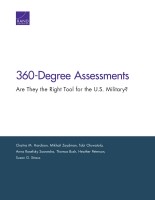| 来源类型 | Research Reports
|
| 规范类型 | 报告
|
| ISBN | 9780833089052
|
| 来源ID | RR-998-OSD
|
| 360-Degree Assessments: Are They the Right Tool for the U.S. Military? |
| Chaitra M. Hardison; Mikhail Zaydman; Tobi A. Oluwatola; Anna Rosefsky Saavedra; Thomas Bush; Heather Peterson; Susan G. Straus
|
| 发表日期 | 2015
|
| 出版年 | 2015
|
| 页码 | 88
|
| 语种 | 英语
|
| 结论 |
Each of the military services and the Joint Staff uses some version of 360-degree assessments. In all cases, the purpose is entirely for individual development, not for evaluation - The Army has the most widespread implementation. In the other services, the use of 360s is more targeted — generally directed at senior leadership or toward high-potential officers as part of the military education system.
Based on our research both within and outside the military setting, we advise against incorporating 360s in the officer evaluation system at this time - The use of 360s for evaluation purposes could ruin their use for developmental applications; implementing two systems could create confusion to raters, increase the survey burden on the force, and create distrust in the process.
- Even more important is the potential for negative impact on selection boards and the promotion process. Information from raters is anonymous, can be inaccurate, could be slanted in an attempt to influence high-stakes decisions, and often requires an understanding of context that may not be available to the board.
We do advise the use of 360s for development purposes for people at higher grades or in leadership positions, which is essentially how the tool is being used today - The tool could be made available as a service to individuals hoping to improve, along with coaching to help service members evaluate the results and incorporate them into self-improvement goals.
- 360s could also be used to provide an aggregate view of leadership performance across the force — something that current tools are not necessarily well positioned to provide. Leaders could use aggregate 360 results to identify force-wide strengths and weaknesses.
Overall, our interviews showed that the spirit of 360 clearly resonates with the services - The services value good leadership behaviors and tools that can help develop good leaders; 360s are one such tool.
- Rather than mandate the use of 360s force-wide, it is more advisable to allow the services to continue on their current paths, expanding the use of 360s in a way that is tailored to individual service needs and goals.
|
| 摘要 |
- The U.S. military should not incorporate 360-degree assessments into the officer performance evaluation system at this time.
- The U.S. military should continue to utilize 360-degree assessments for development purposes within the higher grades and for people in leadership positions.
- The services should be allowed to continue on their current paths, expanding the use of 360s in a way that is tailored to individual service needs and goals.
|
| 主题 | Military Personnel
; Organizational Leadership Development
; Performance Measurement
|
| URL | https://www.rand.org/pubs/research_reports/RR998.html
|
| 来源智库 | RAND Corporation (United States)
|
| 资源类型 | 智库出版物
|
| 条目标识符 | http://119.78.100.153/handle/2XGU8XDN/108076
|
推荐引用方式
GB/T 7714 |
Chaitra M. Hardison,Mikhail Zaydman,Tobi A. Oluwatola,et al. 360-Degree Assessments: Are They the Right Tool for the U.S. Military?. 2015.
|
|
文件名:
|
x1495316329879.jpg
|
|
格式:
|
JPEG
|

|
文件名:
|
RAND_RR998.pdf
|
|
格式:
|
Adobe PDF
|
除非特别说明,本系统中所有内容都受版权保护,并保留所有权利。